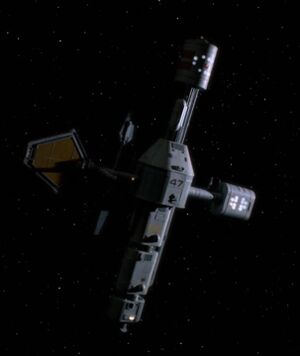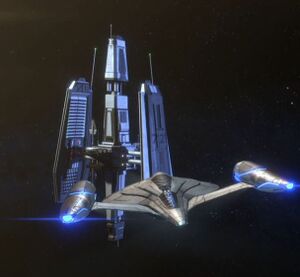Subspace Radio
More actions
Subspace Radio allows for communication across vast distances through subspace. Nearly every warp-capable species uses subspace radio to maintain contact with their distant vessels and to communicate between planets.
Premise of Operation
Subspace radios send signals through subspace, which allows them to travel many thousands of times faster than the speed of light using the same principle that warp drives use. Thus, subspace radios are subject to the same sources of interference that impact warp drives; if a ship cannot go to warp due to local interference, it will also be unable to communicate via subspace. While subspace radios transmit signals at extreme speeds, the distances involved with deep space exploration will still result in communications delays. The speed and range of a transmission is dependent on the size and power of the transmitter being used.
Personal Subspace Radios
Combadges
All Starfleet personnel are issued with combadges, which contain miniaturized subspace transcievers suitable for communication between a planet's surface and a starship or station in orbit. Communications over longer distances require a ship or shuttlecraft to boost the signal. Tricorders and PADDs can connect to the subspace transmitters in their users' combadges to transmit data, video, and audio.
Emergency Transmitters
All Starfleet vessels and auxiliary craft are equipped with emergency transmitters. There are also portable emergency transmitters that come standard in survival equipment and are issued to permanent and semi-permanent research camps. These beacons can transmit a pre-recorded distress message or a custom message on repeat with an effective range of five light-years.
Starship-Based Subspace Radios
Subspace radios transmit messages through subspace, at an average speed of 52,000 times the speed of light for the most powerful starship-based transmitters, or approximately Warp 9.99961. Certain subspace topographical features and weather systems will increase or decrease the speed of messages. This means that at distances of 0.0015 light years or less (14 trillion kilometers), there is essentially no lag. This means that transmissions within a solar system (the Sol system is 288 billion kilometers in diameter). Lag gradually increases as the distance increases at about 10 minutes per light-year, up to 22.65 light-years when transmission decay reaches its upper limit. Thus, the maximum serviceable range of Starfleet subspace radios for audio-visual communication is considered to be 20 light-years, at which range it would take 3 hours and 21 minutes for a message to reach its target. To send a standard subspace message to Starfleet, a starship needs to be within 20 light-years of the nearest Starfleet facility or relay station.
In-Play
- Without a relay, the maximum distance you could send a transmission without degradation is 20 light-years, and it’s a 3-hour and 21 minute wait for a reply. This is the distance crossing one whole sector or one box on the map’s grid. This would apply to ships outside of Federation space.
Subspace Relay Network
The Subspace Relay Network (SRN) is a vast web of boosters and repeaters spread across Federation space that allows for the fast and efficient transmission of messages across long distances. The SRN includes fully-function subspace relay stations, smaller repeater buoys, and relay systems on Federation starbases and other deep space facilities. These facilities use high-power transceivers on fixed alignments to move messages faster than is possible with standard subspace radios, bringing the range of real-time communication up to 20 light-years within the network if a vessel is within 0.0015 light-years of the nearest node in the network. So, each sector starbase has real-time communication with the ships and stations within that sector, but sector-to-sector transmissions are slower, approximately two hours per sector. For example, Starbase Bravo is three sectors away from Earth, so messages take approximately 6 hours to travel between them.
The SRN operates through a hub-and-spoke arrangement, with chains of relay stations connected to subspace relay hubs. Sectors in the interior of the Federation have many more hubs and spokes than outlying sectors, allowing for faster communication.
In-Play
- Facilities within a sector can generally speak to each other in real-time, and ships within that sector can communicate in real-time across the sector, if they are close enough to a relay station or buoy, with every light-year they are away adding ten minutes of lag.
Subspace Relay Stations

Subspace Relay Stations within Federation space have a standard crew of two, who typically serve for one to two years. These stations are unarmed but well-shielded and have a single personnel shuttle at their disposal. They are generally arranged in chains connecting subspace relay hubs at one-light-year intervals, and their purpose is to boost signals they receive towards the hubs to avoid signal degradation. Standard relay stations are connected to two other relay stations, sometimes through intermediate repeater buoys, and can send and receive messages to local starships and stations.
Subspace Repeater Buoys

Subspace Repeater Buoys are small, uncrewed stations that amplify signals from one relay station to another. In outlying sectors, they are often half a light-year between relay stations, while in the core sectors, they may be much closer to one another. The more repeater buoys in the chain, the higher the signal strength and the more precise the resulting communication becomes; they preserve bandwidth along the network. These stations must be serviced regularly by starships.
Deep Space Subspace Relay Station

Deep Space Subspace Relay Stations are larger than standard subspace relay stations and are found at the termini of relay chains at the edge or slightly beyond Federation space. They are armed with phaser turrets and well-shielded, as they are typically several days away from help. They have a standard crew of one person, who typically spends only a year on that assignment. As with other relay stations, they boost signals towards the relay hubs along the chain of relays while also actively scanning for signals outside of explored space. Unlike the more typical stations, they have a facility that allows them to perform limited first-contact functions if they are approached by an unknown species. These stations are connected to just one other relay station, often through intermediate repeater buoys, and can send and receive messages to local starships and stations.
Subspace Relay Hubs

Subspace Relay Hubs connect multiple chains of relay stations together. Some hubs are stand-alone facilities like Epsilon IX Station, while others are contained within starbases. These facilities store and amplify messages across the network. They can be connected to a virtually unlimited number of relay stations.
Planetary Subspace Relay Stations
Subspace Relay Stations can also be built as planetary facilities, particularly when Starfleet sees a need to create a facility that is more defensible than a spaceborne station. An example of this is AR-558, which was seized by Starfleet from the Dominion during the Dominion War.
Gamma and Delta Relay Networks
The Subspace Relay Network has two special spokes that utilize the Bajoran and Barzan Wormholes to connect with ships in the Gamma and Delta Quadrants respectively. Wormhole relay stations are situated at the far ends of both of these wormholes, though the nature of their functionality is different: the Bajoran wormhole is stable and non-cyclical, and its relay station (rebuilt after the Dominion War) is capable of sending messages at any time, while the Barzan wormhole moves between two end-points and so can only periodically send and receive messages, generally every 30 days.
In the Gamma Quadrant, a chain of deep space subspace relays connects the wormhole relay to New Bajor and Opaka Outpost. They are labeled Gamma-[Number], and are known as the Gamma Relays.
The network in the Delta Quadrant is more extensive. There are chains in the Gradin Belt and Nacene Reach connecting the wormhole relays to allies in the region. In the Gradin Belt, these stations are labeled with the prefix Delta-G-[Number] and in the Nacene Reach, they are labeled with the prefix Delta-N-[Number], known colloquially as the Delta-Golf Relays and the Delta-November Relays.
In-Play
- In the Gamma Quadrant, if you are close enough to New Bajor for real time contact, you are also close enough to send a real-time message through the Bajoran Wormhole. Otherwise, the same rules apply: you need to be within 20 light-years of New Bajor to send an asynchronous message back to Starfleet without signal degredation.
- In the Delta Quadrant, things are more complicated. Real-time communication is possible with proximity to the network between ships in the Delta Quadrant, but the Nacene Reach and Gradin Belt networks are not connected directly. To send a message from one network to the other, you'd need to wait for it to be sent through the wormhole relay to Starbase 38 and then back through to the other side, which could take up to two months if you missed one of the transmission windows.
- Real-time communication between the Delta Quadrant and Starbase 38 is only possible when the wormhole is active, at least through this system.

